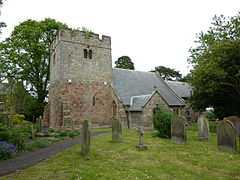Longhoughton, Northumberland
| Longhoughton | |
 Longhoughton Church |
|
 Longhoughton | |
| Population | 1,442 (2001 census)[1] |
|---|---|
| OS grid reference | NU244155 |
| Shire county | Northumberland |
| Region | North East |
| Country | England |
| Sovereign state | United Kingdom |
| Post town | ALNWICK |
| Postcode district | NE66 |
| Police | Northumbria |
| Fire | Northumberland |
| Ambulance | North East |
| EU Parliament | North East England |
| UK Parliament | Berwick-upon-Tweed |
| |
Longhoughton is a small rural village in Northumberland, England. It lies near the coast, about 4.5 miles (7.2 km) northeast of Alnwick, in the similarly named parish of Longhoughton.
The village lies under the spectacular whinstone outcrop, Ratcheugh Crag, near which local point-to-point racing is often conducted.
Longhoughton church does double-duty as the church of the nearby RAF Boulmer
History
The village has a turbulent history and was often sacked in Medieval times. From the 12th century until recently, the village was noted for its water and corn mills.[2]
There was local industry based on limestone, coal and lead; although agriculture was always the main occupation.
On top of Ratcheugh Crag is a Robert Adam-designed observatory, built by Hugh Percy, 1st Duke of Northumberland.
Governance
Longhoughton is in the parliamentary constituency of Berwick-upon-Tweed.
Transport
Longhoughton once had a railway station on the main line of the North Eastern Railway. Longhoughton goods yard still exists and is used for storage of rolling stock by the Aln Valley Railway and Northumbria Rail Ltd.[3]
Buildings
The parish church of St. Peter and St. Paul dates from the Saxon era, although it was rebuilt in 1080 and now the only remaining Saxon stonework is seen in parts of the chancel and tower arches. During the 1080 rebuilding, a 44-foot (13 m) tower was added. This was for purposes of military defence, rather than religious use, and was used as such until the 17th century. Parish records go back as far as 1646.
Smugglers used to use the church as a distribution centre in the 19th century. Nikolaus Pevsner mentioned the building favourably in his review of Northumbrian architecture.
A little over a mile to the north-west is Littlehoughton Hall, a house of 1686 with later additions, which incorporates the remains of a late medieval tower house.[4]
References
External links
| Wikimedia Commons has media related to Longhoughton, Northumberland. |
- GENUKI (accessed: 26 November 2008)
- Northumberland Communities (accessed: 26 November 2008)